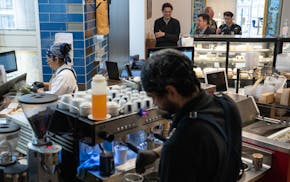After decades of development and trials, Medtronic has secured U.S. Food and Drug Administration approval for adaptive technology personalizing treatment of Parkinson's symptoms using advanced stimulation deep in the brain.
On Monday, the Fridley-run company announced the regulatory win for its BrainSense Adaptive deep brain stimulation in a thin, surgically implanted neurostimulator in the chest with leads stretching through the neck to the brain. It builds on long-available deep brain stimulation (DBS) technology working sort of like a pacemaker in the brain, continuously delivering pulses of electric current to the structures with abnormal activity to treat disease symptoms like a tremor.
Instead of continuously stimulating at full force, the new technology adapts its stimulation amplitude to not overcorrect or undercorrect the effects of medication treatment for Parkinson's symptoms, which had previously occurred, said Dr. Helen Bronte-Stewart, a Stanford professor who was the global principal investigator for the trial behind the therapy.
"This is the beginning of a whole new way of delivering stimulation to the brain, just like it was to the heart," Bronte-Stewart said, comparing the technology to the pacemaker. Clinical trial results are not yet published.
Medtronic Neuroscience President Brett Wall called the system an engineering marvel.
"What patients want to do is forget they have this disease," said Wall, who is also an executive vice president. "And while we don't cure the underlying issues here, we give them symptom relief. It allows them to go on with their lives in a normal way."
The Parkinson's Foundation reports that 1 million people in the United States are living with the neurodegenerative disorder killing dopamine-producing neurons in the brain. Dr. Michael Okun, a medical adviser for the Parkinson's Foundation, said in an email the disease is one of the most complex, with more than 20 motor and nonmotor symptoms.
"Neuroscientists have been on a decadeslong journey to decode brain signals to personalize the deep brain stimulation experience," said Okun, who's also the director of the Norman Fixel Institute for Neurological Diseases at University of Florida Health. "Adaptive devices hold the potential to 'open up' more options for chronic neurological diseases such as Parkinson's."
After achieving approval for the use of deep brain stimulation for Parkinson's in the late 1990s, Medtronic scientists wondered if there was a way to leverage brain signals to customize therapy based on when a patient is going through a period of overtreatment of undertreatment, senior distinguished engineer Scott Stanslaski said.
"So, by being able to detect when the brain is going through those states and then automatically adjusting the DBS therapy ... we can better balance those types of fluctuations and give the patients an overall smoother treatment," said Stanslaski, who invented the BrainSense sensing-enabled DBS feature.
The technology was first implanted into a human in 2013 and went through several rounds of trials with dozens of patients afterward, Stanslaski said.
Monday's announcement includes approval for the BrainSense adaptive deep-brain stimulation feature for personalized therapy, as well as a piece of equipment called the BrainSense Electrode Identifier, which works with Medtronic's Percept neurostimulator by providing doctors a real-time snapshot of a patient's brain signals for programming purposes, the company said.
Medtronic, Boston Scientific and Abbott Laboratories, which all have large presences in the Twin Cities, have long used deep brain stimulation to treat diseases like Parkinson's, said Dr. Jerrold Vitek, the chair of Department of Neurology at the University of Minnesota's Medical school. Medtronic is the first to make the technology adaptive for Parkinson's patients, he said.
"It's just another step in advancing the ability to use this really powerful tool for the treatment of things like movement disorders" and other maladies, Vitek said, suggesting researchers could study the use of adaptive technology for illnesses such as obsessive compulsive disorder.

Why now might be the best time to make a deal on boats, ATVs and other powersports

To reset downtown Minneapolis skyway life, building owners cut deals with retailers

Ramstad: AI is English-centric, but it's picking up Hmong quickly
Don't throw away perks that come with insurance and memberships
